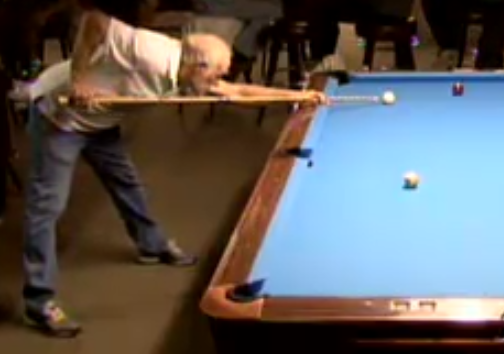Greg -- Do you incorporate "quiet eyes" into your CB-last eye pattern at all? If so, how -- are you "quiet" on the OB and then switch back briefly to the CB before the hit, or are you "quiet" on the CB before the stroke, or something else?
While I have heard the term "quiet eyes", I am not sure I know what it means.:wink: OK, just educated myself.
'Quiet Eye' helps elite athletes
What is working for me is more of a factor of my entire preshot routine and sighting along with 'quiet eye' on the cue ball at contact and through. I aim the object ball while standing squarely at address. I was taught to line up the shot using my belly button.
I think Jerry Briesath teaches a similar way, he describes putting the chin on the line and keeping it there. From address I stride with my left foot forward and my right foot slightly back. Putting my cue on the line of sight as if I were going to shoot the shot one handed. This has my right hand slightly behind the balance point of the cue and at my finish position of my normal stroke. This is against my pectoral muscle or very close. This is my second stage of aiming. Until now my eyes have been on the object ball. At this point I look at the line of my cue and confirm that it is on the line of the shot. From there I look at the cue ball until my bridege is set. Then I slide my right hand back to perpendicular at address and take my practice stroke looking at the cue ball and when the stroke stops I follow the line it creates and confirm that it will take the cue ball to the point of aim on the object ball(look at the object ball). I normally stroke twice. If all is good I draw my cue back looking at the cue ball and pause(the timing). I draw my dominant left eye to the exact point I am striking on the cue ball(the precision of focus part) and watch as the cue contacts it and my vision stays with the cue ball until contact with the object ball. I am focused on the contact point and the line the cue tip should take through the cue ball.
Thank you for bringing the 'Quiet eyes' to my attention. I am going to throw in a quote from the link I included, as I found it very interesting.
[quote='Quiet Eye' helps elite athletes
By Julie Clothier for CNN]The first is the optimal location of the eyes' focus in space. For example, the best place on which to focus in golf is the back of the ball, while in basketball it is the front of the hoop.
"The precision of the quiet eye location often mirrors the precision required to perform well in a sport. In golf, precision of movement and precision of focus are paramount," says Vickers.
The second is the when the eyes begin to focus. The timing of focus is crucial, says Vickers, and varies depending on the sport.
The third is when the players' gaze leaves the "optimal location."
"In golf putting, for example, it has to stay on the back of the ball through the stroke and dwell for 200 or 300m on the green, after contact. Most golfers do not do this consistently," says Vickers.
The final quality is the duration of the quiet eye's period.
"It's about their ability to maintain a single focus even as all the motor activity is going on," she says.
"The top athletes that I work with have wonderful physical attributes but what some of them lack is visual focus and concentration," she says.[/quote]
In closing it would seem that my method would relate to the golf putting she describes while object ball last could relate to the basketball shooting.
1. I find my optimal location to be the cue ball.
2. The timing of my focus is the pause at the back of the stroke.
3. My gaze stays with the cue ball until contact with the object ball.
The final quality of duration is indeed the thing that I am constantly trying to improve.
